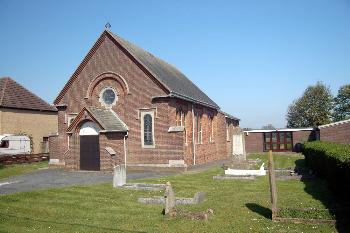Methodism in Kensworth
![The Wesleyan Chapel about 1910 [Z883/7]](/CommunityHistories/Kensworth/Kensworthimages/The Wesleyan Chapel about 1910 [Z883-7].jpg)
The Wesleyan Chapel about 1910 [Z883/7]
The earliest contemporary mention Kensworth appears on the Luton Wesleyan Circuit Plan in 1813, though there are claims for an earlier history. A centenary brochure of 1947 [MB1835] claims: “Kensworth has a great past, for it is recorded that John Wesley preached there on one of his journeys”. Wesley’s own journals do not mention visiting Kensworth but he was active in Luton. The brochure also claims: “A John Walker, one time Parish Clerk, was converted as far back as 1733”.
A Wesleyan chapel in Kensworth was first registered in 1830 by William Pollard. In 1843 Kensworth moved from Luton to Dunstable Wesleyan Circuit. The centenary brochure states: “in October 1846 Miss Mary Fossey sold land to Mr. James Munn for the purpose of a site for a Wesleyan Chapel”. Certainly this new chapel was registered in 1847 by Wright Shovelton, circuit minister, and was again re-registered in 1854 by Matthew Trevan Male of Dunstable, the superintendent minister.
The centenary brochure states: “The Trust was formed on April 23rd, 1847, when the Rev. Wright Shovelton was Superintendent Minister and the first Trustees were, Benjamin Bennett [a Dunstable brewer], Richard Walton, William Turney, Jabez Bartram and George Garrett, all of Dunstable, William Holland, Thomas Vass, Thomas Page of Kensworth, William Neale of Dagnall [Buckinghamshire], John Jones of Little Gaddesden [Hertfordshire], William Higgins of Luton, Richard Barton of Toddington, William Labrum of Hockliffe and James Hawes of Markyate [Hertfordshire]”.
The Bedfordshire Times of 25th March 1848 reported: “The old Wesleyan Chapel in this village having been purchased by Thomas Jones, Esq., of London, and fitted up for the purposes of a School Room, a public meeting of the inhabitants was held therein, on Friday afternoon, March the 17th, for the purpose of explaining the nature and importance of the British School system about to be adopted and maintained at the charge of Mr. Jones”.
On Sunday 30th March 1851 a census of all churches, chapels and preaching-houses of every denomination was undertaken in England and Wales. The local results were published by Bedfordshire Historical Records Society in 1975 as Volume 54, edited by D. W. Bushby. The return for the Wesleyan Methodist chapel was made by one of the trustees, James Munn. He noted that the chapel was built in 1847 “in lieu of one built in 1830”; it had 190 free seats, 202 other seats and standing room for 50. The general congregation had been 114 in the morning, with 106 Sunday scholars, 171 in the afternoon, with 122 Sunday scholars and 332 in the evening. The average attendance for the three services was just over 280, compared with 23 for the Baptists, 53 for the Mormons and 98 at the church, making Methodism easily the dominant form of worship in the parish.
The centenary brochure records renewal of the trusts in 1880 and 1912. the names of the 1880 trustees were: James Munn, James Elim, Thomas Vass of Kensworth, John Hay of Whipsnade, John Jones of Little Gaddesden and the following men from Dunstable: Edwin J. Lester; Charles Lockhart; Walter Lester; James Tearle; Frederick Girling; Thomson Smallwood; David Dolemore; Alfred Pitkins; Edwin George; William Turney; Thomas Weatherill and James Tibbett. The names of the 1912 trustees were: F. Creak; Joseph Andrews; William Durrant; Melville Lockhart; Percy Willison; Charles F. Moore; Percy Lester; David Durrant; A. S. Willis and Alfred King.
The centenary brochure continues: “The First World War came and nearly every family was affected. Some of the best of the young men fell, and the Chapel suffered a great loss. A few came back, and one of them, the Steward and Secretary, felt, as a thank offering to God, he would give all his powers to build a new Chapel and calling the friends together, and with unity and full purpose the scheme was launched”.
“A very extensive renovation scheme was carried through when the Rev. J. Schofield Morris was Superintendent, costing over £200, but the need for a new Chapel was greatly felt”.
“To make the scheme possible Mr. Frederick Escott, Mr. Stanley Bennett and Mr. Joseph Rank each gave £100 to start and from that time he never looked back and with the splendid help of the other Stewards, Mr. George Skinner, Mr. Percy Moulster, Mr. Dennis Willis, Mr. Edwin Cutler and the willing lady workers and the Circuit, the scheme was completed at a cost of £1275”.
“The Rev. H. B. Brewin was the Minister and Mr. Joseph Andrews, Treasurer during these years. The opening was in 1934”. The brochure went on to look to the future: “But for many people, the old Chapel with its large gallery, still has fragrant memories, so we celebrate its Centenary, July, this year”.
“Part of it is built into the present Chapel and will continue as a pleasant link ‘tween past and future, reminding those who live in the next century of the worthies of the past century, by whose faith and service the Methodist witness has been sustained for so long”.
“The financial appeal is on behalf of Renovation and Extension Funds, as we greatly need vestry, kitchen and toilet accommodation”.
At the time of writing Kensworth forms part of the South Bedfordshire Circuit. Sadly, Bedfordshire and Luton Archives and Records Service has very few records from the chapel itself. They are as follows:
- MB1835: Centenary booklet: 1847-1947;
- MB1821: Church Council minute book: 1975-1981;
- MB2940: Chapel correspondence: 1975-1999;
- MB2941: Church Council minutes: 1990-1992;
- MB3104: Church Council minutes and annual accounts: 1992-2001.
The former Methodist burial ground at the chapel survives. In 1967 the parish council gave money, derived from the sale of allotment land, to extend the burial ground for use of anyone in the parish [PCKensworth12/1].

Kensworth Methodist chapel April 2007